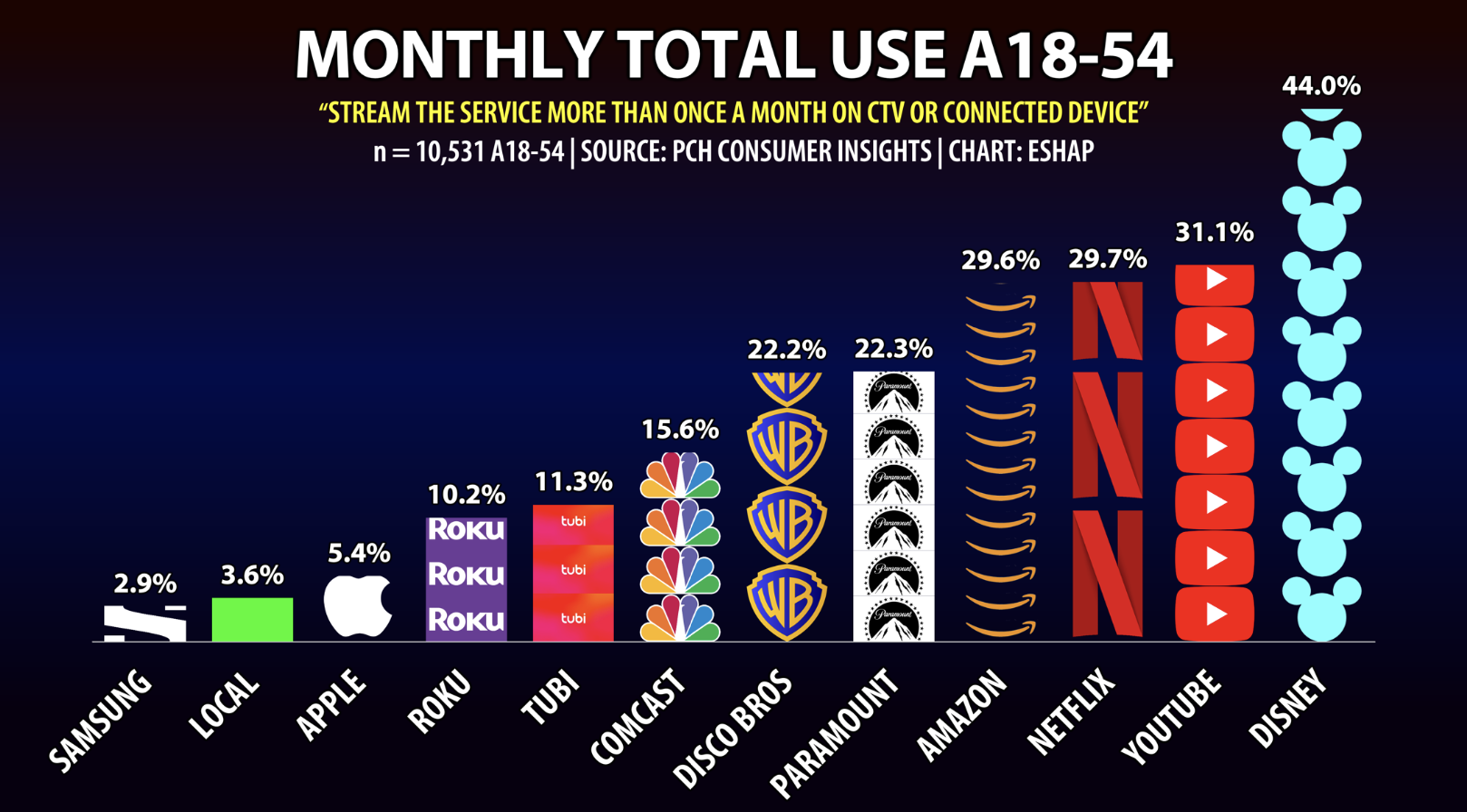Streaming May Be In Flux, But Disney And YouTube Are In Control
”Streaming In Flux” the latest consumer research report from Publishers Clearing House and Evan Shapiro’s ESHAP is out and it reveals that the industry is maturing.
Sort of.
Some key findings:
Free streaming is more popular than paid streaming, though viewers over 45 still watch more traditional linear.
When you combine the various holding company properties together, Disney comes out on top, largely due to the popularity of Hulu. (Meaning Bob Iger should think twice before letting it go.)
Even more surprising is the size of Disney’s lead— 44.0% report streaming a Disney service at least once a month, versus #2 YouTube at 31.1%.
That YouTube stat is also notable in that the survey specifically asked consumers which services they watched on their TV sets, not their phones and laptops. This confirms something we’ve been noticing—that YouTube viewing on TV sets appears to be skyrocketing (See Nielsen’s “The Gauge” ratings for similar findings.)
YouTube viewing is slightly heavier among viewers under 45, where it edged out Netflix for the number one spot, 35.2% to 33.6%. The reverse was true among the 45-54 set, where Netflix maintained a more commanding lead, 28.4% to 22.2%.
Still, the fact that YouTube is in the number two position among that latter group is telling and raises an even bigger question:
Is YouTube TV?
This is going to be a massive bone of contention between the industry. advertisers and Alphabet over the next few years, with no real resolution, because the answer, unfortunately is “it depends.”
Much of what is on YouTube is indeed low-budget, low production value user-generated “content” with all the pejoratives that word calls up.
But there's also a growing body of work on there that rises above—web series and short films created by people who have worked at mainstream TV networks and movie studios, many of which feature high production values and run at or close to 20 minutes, the number generally accepted as the “cut-off” for TV.
So a lot of shades of gray and a lot of room for interpretation.
The ultimate decision as to whether YouTube is considered “TV” is in the hands of advertisers, who must decide whether they want to keep YouTube in their TV budget, versus making it part of digital or digital video.
Given that there is unlikely to be anything vaguely resembling conformity on this from advertisers, it will be years, if not decades, before it shakes out.
Consumers will likely have a say too—if I were an advertiser I’d want to see a study that looks at whether viewers consider YouTube to be just another flavor of TV or something else entirely.
And I’d want that study recommissioned every two years or so, given the way things change.
Alphabet itself can also help to make the matter easier to resolve by separating out programming that more easily falls into the “TV” bucket and standardizing their advertising to be more like other streaming services.
That seems unlikely, however, as Alphabet, which does not even break out YouTube revenue from Google revenue, will not want to expose just how much of their viewing is attributable to different types of content and/or to create different ad formats.
Especially if advertisers are not asking them to.
YouTube’s growing dominance aside, there was one more interesting finding, which was that vMVPDs, the streaming pay-TV services from Hulu, YouTube, DirecTV, Sling and Fubo now account for a sizable percentage of viewing time, with 17% of 18-44 year olds and 15% of 45-54 year olds saying they watched vMVPDs either daily or weekly.
That number is right on the heels of the number of 18 to 45 year olds who say they watch MVPDs (old school cable and satellite) weekly- 17% for vMVPDs and 20% for MVPDs.
Again, this is not all that surprising.
vMVPDs are a nicotine patch for cord cutting—it lets you do away with the cable box while still retaining access to close to 100 channels, few of which you’ll ever actually watch.
But you could watch them if you wanted to, and for many viewers, that’s an important distinction.
vMVPDs are also ideal for younger viewers who move around a lot, as they don’t require a visit from a set top box installer, allow subscribers to take their preferences and saved shows with them when they move, and provide access to cable news and live sports.
Which is why we expect them to keep growing, at least for the next few years, as viewers gingerly see what it’s like to not have a pay TV subscription and as the migration of RSNs and live news to streaming makes that an easier choice.
Click here to read the report and its full findings, it’s a free download, courtesy of TVREV.




